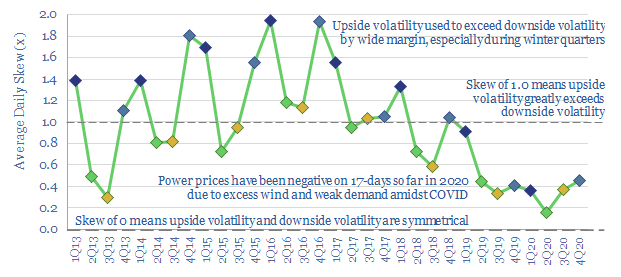UK wind power has almost trebled since 2016. But its output is volatile, now varying between 0-50% of the total grid. Hence this 14-page note assesses the volatility, using granular, hour-by-hour data from 2020. EV charging and smart energy systems screen as the best new opportunities. Gas-fired backups also remain crucial to ensure grid stability. The outlook for grid-scale batteries has actually worsened. Finally, downside risks are quantified for future realized wind power prices.
This rise of renewables in the UK power grid is profiled on page 2, showing how wind has displaced coal and gas to-date.
But wind is volatile, as is shown on page 3, thus the hourly volatility within the UK grid is 2.5x higher than in 2016.
Power prices have debatably increased due to the scale-up of wind, as shown on page 4.
But price volatility measures are mixed, as presented on pages 5-6. We conclude that the latest data actually challenge the case for grid-scale batteries and green hydrogen.
Downside volatility has increased most, as is quantified on pages 7-8, finding a vast acceleration in negative power pricing, particularly in 2020.
The best opportunities are therefore in absorbing excess wind power. EV charging and smart energy systems are shown to be best-placed to benefit, on pages 9-10.
Upside volatility in power prices has not increased yet, but it will do, if gas plants shutter. The challenge is presented on pages 11-13, including comparisons with Californian solar.
Future power prices realized by wind assets are also likely to be lower than the average power prices across the UK grid, as is quantified on page 14. This may be a risk for unsubsidized wind projects, or when contracts for difference have expired.
